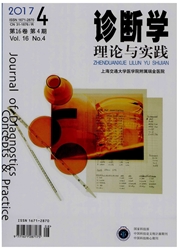

 中文摘要:
中文摘要:
目的 :探讨乳腺疾病超声弹性成像在乳腺影像学报告及数据系统(Breast Imaging Reporting and Data System,BI-RADS)-US第二版中的临床应用价值。方法 :纳入253例乳腺疾病患者共263个病灶,患者术前行常规超声检查及超声弹性成像检查,使用BI-RADS-US第二版超声弹性成像分级法、Itoh 5分法、弹性应变率比值(strain ratio,SR)法对其乳腺病灶进行BI-RADS-US分类,并将结果与病理结果对照分析。结果 :SR联合常规超声检查诊断乳腺恶性病灶的灵敏度为92.31%,稍好于Itoh 5分法、BI-RADS-US第二版超声弹性成像分级法与常规超声的联合,但明显好于单独应用Itoh 5分法、BI-RADS-US第二版超声弹性成像分级法及SR法。在良性病灶需活检率方面,采用常规超声检查最高,为46.62%;通过SR法联合常规超声检查最低,为27.82%;BI-RADS-US第二版超声弹性成像分级法联合常规超声检查为30.83%;Itoh 5分法联合常规超声为39.85%。结论:超声弹性成像诊断乳腺病灶有一定的局限性,但超声弹性成像联合常规超声检查则能有效降低良性病灶的活检率,减少患者的痛苦。
 英文摘要:
英文摘要:
Objective To investigate the value of ultrasound elastography in differentiating breast diseases using the second edition of BI-RADS-US. Methods: Two hundred and fifty-three patients with 263 lesions were included in this studies. All of them underwent conventional ultrasonography and ultrasonic elastography before surgery. The histopathologic results were used as gold standards. Results: The sensitivity for diagnosing malignant breast disease by SR(strain ratio) of elastography combined with conventional ultrasonography was 92.31%, which was slightly higher than the combining of conventional ultrasonography with Itoh's 5 scores and 2nd edition of BI-RADS-US classification of elastography, and was significantly higher than using each of these methods of elastography alone. The biopsy applied rate of benign lesions was the highest in conventional ultrasounography(46.62%), and was 27.82% in SR of elastography combined with conventional ultrasounography, 30.83% in 2nd edition BI-RADS-US classification of elastography combined with conventional ultrasounography, 39.85% in Itoh′ s 5 scores of elastography combined with conventional ultrasounography. Conclusions: Despite the limitation of elastography in the differentiation of breast diseases, elastography combined with conventional ultrasonography could reduce unnecessary biopsy and finally benefit the patients.
 同期刊论文项目
同期刊论文项目
 同项目期刊论文
同项目期刊论文
 F127/Calcium phosphate hybrid nanoparticles: a promising vector for improving siRNA delivery and gen
F127/Calcium phosphate hybrid nanoparticles: a promising vector for improving siRNA delivery and gen EGF-modified mPEG-PLGA-PLL nanoparticle for delivering doxorubicin combined with Bcl-2 siRNA as a po
EGF-modified mPEG-PLGA-PLL nanoparticle for delivering doxorubicin combined with Bcl-2 siRNA as a po Three-dimensional contrast enhanced ultrasound score and dynamic contrast-enhanced magnetic resonanc
Three-dimensional contrast enhanced ultrasound score and dynamic contrast-enhanced magnetic resonanc 期刊信息
期刊信息
